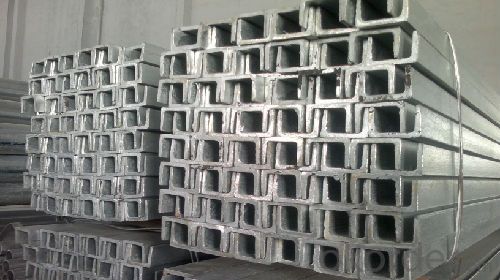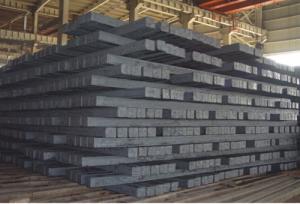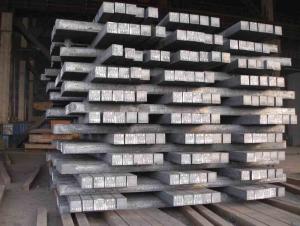JIS U Channel 50-300MM Hot Rolled EN10025JR High Quality
- Loading Port:
- Shanghai
- Payment Terms:
- TT or LC
- Min Order Qty:
- 25 m.t.
- Supply Capability:
- 20000 m.t./month
OKorder Service Pledge
OKorder Financial Service
You Might Also Like
Product Description:
OKorder is offering high quality Hot Rolled Steel I-Beams at great prices with worldwide shipping. Our supplier is a world-class manufacturer of steel, with our products utilized the world over. OKorder annually supplies products to European, North American and Asian markets. We provide quotations within 24 hours of receiving an inquiry and guarantee competitive prices.
Product Applications:
According to the needs of different structures, Angle can compose to different force support component, and also can be the connections between components. It is widely used in various building structures and engineering structures such as roof beams, bridges, transmission towers, hoisting machinery and transport machinery, ships, industrial furnaces, reaction tower, container frame and warehouse etc
Product Advantages:
OKorder's Steel I-Beams are durable, strong, and resist corrosion.
Main Product Features:
· Premium quality
· Prompt delivery & seaworthy packing (30 days after receiving deposit)
· Corrosion resistance
· Can be recycled and reused
· Mill test certification
· Professional Service
· Competitive pricing
Product Specifications:
Manufacture: Hot rolled
Grade: Q195 – 235
Certificates: ISO, SGS, BV, CIQ
Length: 6m – 12m, as per customer request
Packaging: Export packing, nude packing, bundled
Sizes: 25mm-250mm | ||||||||||||
a*t | ||||||||||||
25*2.5-4.0 | 70*6.0-9.0 | 130*9.0-15 | ||||||||||
30*2.5-6.6 | 75*6.0-9.0 | 140*10-14 | ||||||||||
36*3.0-5.0 | 80*5.0-10 | 150*10-20 | ||||||||||
38*2.3-6.0 | 90*7.0-10 | 160*10-16 | ||||||||||
40*3.0-5.0 | 100*6.0-12 | 175*12-15 | ||||||||||
45*4.0-6.0 | 110*8.0-10 | 180*12-18 | ||||||||||
50*4.0-6.0 | 120*6.0-15 | 200*14-25 | ||||||||||
60*4.0-8.0 | 125*8.0-14 | 250*25 | ||||||||||
FAQ:
Q1: Why buy Materials & Equipment from OKorder.com?
A1: All products offered byOKorder.com are carefully selected from China's most reliable manufacturing enterprises. Through its ISO certifications, OKorder.com adheres to the highest standards and a commitment to supply chain safety and customer satisfaction.
Q2: How do we guarantee the quality of our products?
A2: We have established an advanced quality management system which conducts strict quality tests at every step, from raw materials to the final product. At the same time, we provide extensive follow-up service assurances as required.
Q3: How soon can we receive the product after purchase?
A3: Within three days of placing an order, we will begin production. The specific shipping date is dependent upon international and government factors, but is typically 7 to 10 workdays.


- Q:How are steel billets used in the production of pressure vessels?
- Steel billets are used in the production of pressure vessels as the starting material for forging, rolling, or extrusion processes. These billets are heated and shaped into the desired form, such as plates or shells, which are then welded together to create the pressure vessel. The high strength and durability of steel billets ensure that the pressure vessel can withstand the high internal pressure and harsh operating conditions it may be subjected to.
- Q:What are the different surface treatments for improved weldability in steel billets?
- There are several surface treatments that can be employed to enhance the weldability of steel billets. These treatments are aimed at improving the cleanliness and quality of the surface, reducing impurities, and enhancing the overall performance of the weld. One common surface treatment method is mechanical cleaning. This process involves the removal of loose scale, rust, dirt, and other contaminants from the surface of the steel billets. Mechanical cleaning methods can include grinding, brushing, or shot blasting. By eliminating these impurities, the surface is prepared for better adhesion and fusion during the welding process. Another surface treatment option is chemical cleaning. This technique involves the use of various chemicals to remove oxides, oils, greases, and other organic or inorganic contaminants from the surface. Acid pickling is a commonly used chemical cleaning method, where the steel billets are immersed in an acid solution to dissolve and remove impurities. This process creates a clean and reactive surface that promotes better weldability. In addition to mechanical and chemical cleaning, surface coatings can also be applied to improve weldability. These coatings act as a barrier between the steel surface and the surrounding atmosphere, protecting it from oxidation and contamination during the welding process. Common coatings used for this purpose include zinc-based coatings, such as galvanizing or zinc-rich paints. These coatings not only protect the surface but also provide cathodic protection to prevent corrosion. Furthermore, some steel billets may undergo heat treatment processes to improve their weldability. Heat treatment involves subjecting the steel to controlled heating and cooling cycles to alter its microstructure and mechanical properties. Through heat treatment, the steel billets can be made more ductile, reducing the risk of cracking or failure during welding. Overall, the different surface treatments for improved weldability in steel billets include mechanical cleaning, chemical cleaning, surface coatings, and heat treatment. These treatments aim to remove impurities, increase cleanliness, and enhance the overall weldability of the steel, resulting in higher quality and more reliable welds.
- Q:What are the properties and characteristics of steel billets?
- Steel billets are semi-finished products that possess several key properties and characteristics. Firstly, they have a rectangular or square cross-section with a relatively large size, typically ranging from 100x100mm to 200x200mm. They are manufactured through the process of continuous casting, which ensures their uniform composition and high quality. Steel billets exhibit excellent strength and hardness, making them suitable for various applications in the manufacturing industry. They have a high resistance to deformation, enabling them to withstand heavy loads and pressures. Additionally, they have good ductility and can be easily shaped or formed into desired products through processes like rolling or forging. Another important characteristic of steel billets is their excellent thermal conductivity, enabling efficient heat transfer during processing. They also have a good resistance to corrosion, which makes them suitable for outdoor applications and in environments with high humidity or exposure to chemicals. Overall, steel billets are versatile and robust materials with a wide range of applications in the construction, automotive, and machinery industries, among others. Their distinctive properties make them a preferred choice for various manufacturing processes, enabling the production of durable and reliable end products.
- Q:What are the different types of defects that can occur during casting of steel billets?
- During the casting of steel billets, several types of defects can occur, affecting the quality and integrity of the final product. Some common defects include: 1. Shrinkage: Shrinkage defects occur when the metal cools and solidifies unevenly, causing voids or shrinkage cavities in the billet. This can weaken the structure and reduce its overall strength. 2. Porosity: Porosity refers to the presence of trapped gas or air bubbles in the billet. It can occur due to improper gating or venting, inadequate control of the pouring temperature, or the presence of impurities in the molten metal. Porosity can reduce the billet's mechanical properties and make it more susceptible to failure. 3. Inclusions: Inclusions are non-metallic materials, such as oxides, sulfides, or refractory particles, that get trapped in the billet during casting. These inclusions can weaken the metal, leading to reduced ductility, increased brittleness, and decreased resistance to fatigue or corrosion. 4. Cold shuts: Cold shuts happen when two streams of molten metal fail to fuse properly during casting, resulting in a visible line or seam in the billet. Cold shuts can weaken the billet and cause it to fail under stress. 5. Hot tearing: Hot tearing occurs when the solidifying metal is restrained from contracting, leading to localized cracking or tearing. It usually happens due to high thermal stresses or inadequate feeding of the metal during solidification. Hot tearing can significantly affect the billet's structural integrity. 6. Misruns: Misruns are defects that occur when the molten metal fails to fill the entire mold cavity completely. This can happen due to inadequate pouring temperature, improper gating or venting, or insufficient fluidity of the metal. Misruns can result in incomplete, undersized, or malformed billets with reduced mechanical properties. 7. Surface defects: Surface defects include surface cracks, scabs, or surface roughness that can occur during the solidification or cooling process. These defects can lead to increased rejection rates, reduced machinability, and compromised surface finish of the billet. It is crucial to identify and minimize these defects during the casting process to ensure the production of high-quality steel billets with the desired mechanical properties and dimensional accuracy.
- Q:How do steel billets contribute to the aerospace industry?
- Steel billets are an essential component in the aerospace industry as they serve as the raw material for manufacturing various critical parts and components. These billets are used to produce high-strength and lightweight steel alloys that are crucial for aircraft structures, such as fuselages, wings, and landing gears. The superior strength and durability of steel billets allow for the construction of robust and reliable aircraft, ensuring safety and performance in demanding aerospace operations.
- Q:How are steel billets used in the manufacturing of agricultural machinery parts?
- Steel billets serve as a crucial raw material for the production of agricultural machinery parts. These billets are essentially semi-finished steel products that act as a starting point for various manufacturing processes. To begin with, steel billets are molded into specific shapes using a range of techniques such as casting, rolling, or extrusion. These processes facilitate the transformation of solid billets into desired forms like bars, rods, or sheets, which then serve as the foundational materials for agricultural machinery parts. After the billets have been shaped, they undergo further refinement through machining, cutting, and welding procedures to create precise components for agricultural machinery. For instance, billets can be machined into shafts, gears, or axles that are integral to the functioning of these machinery parts. Furthermore, the robustness and durability of steel billets make them well-suited for use in heavy machinery like tractors, combines, or harvesters. Agricultural machinery parts manufactured from steel billets possess exceptional tensile strength, resistance to wear and tear, and the ability to withstand the demanding conditions encountered in the agricultural sector. Moreover, steel billets can be subjected to heat treatment to enhance their mechanical properties, such as hardness or toughness, thereby making them more resilient and capable of enduring substantial loads and extreme conditions. This makes them an ideal choice for agricultural machinery parts that frequently encounter intense forces during operation. Additionally, steel billets can be utilized in the production of precision components, such as bearings or bushings, which are vital for the smooth and efficient operation of agricultural machinery. The dimensional accuracy and consistency of steel billets ensure that these precision parts fit flawlessly and perform effectively. Overall, steel billets play a pivotal role in the manufacture of agricultural machinery parts. Their versatility, strength, and ability to be shaped and processed make them an indispensable material in the production of components that can withstand the demanding and challenging conditions prevalent in the agricultural industry.
- Q:How are steel billets transported internationally?
- Steel billets are transported internationally through various modes of transportation depending on the distance, quantity, and urgency of the shipment. The most common methods include shipping, rail, and road transportation. For long-distance international transport, shipping is the preferred mode. Steel billets are loaded into shipping containers, typically either 20-foot or 40-foot containers, and secured to prevent movement during transit. These containers are then transported by cargo ships, which offer large storage capacities and efficient transportation over vast distances. Shipping containers are designed to protect the steel billets from external elements such as moisture and corrosion, ensuring their integrity upon arrival. Rail transport is also utilized for international shipments, especially for destinations connected by rail networks. Steel billets are loaded onto railcars, either in open-top or covered wagons depending on the requirements and weather conditions. Rail transportation is often preferred for its cost-effectiveness, capacity to handle large volumes, and ability to reach landlocked regions. In cases where the distance is relatively short or when the shipment requires quick delivery, road transportation is employed. Steel billets are loaded onto flatbed trucks or trailers, securely tied down to prevent any movement, and transported to their destination. Road transport offers flexibility, as it allows direct delivery to the intended location, including areas where other modes of transport may face limitations. Regardless of the mode of transportation, international shipments of steel billets require proper documentation, including customs clearance, bill of lading, and other relevant paperwork. These ensure compliance with international trade regulations, smooth border crossings, and timely delivery of the steel billets to their destination.
- Q:What are the different surface treatments for corrosion resistance in steel billets?
- Steel billets can be enhanced for corrosion resistance through various surface treatments. These treatments play a crucial role in preventing rust and oxidation, which can greatly degrade the quality and lifespan of the billets. Some commonly used surface treatments for corrosion resistance in steel billets are as follows: 1. Hot-dip galvanizing: By immersing the steel billets in molten zinc, a protective coating is formed on the surface. This zinc coating acts as a sacrificial layer, safeguarding the steel against corrosion. 2. Electroplating: Through an electrochemical process, a thin layer of a corrosion-resistant metal like nickel or chromium is deposited onto the surface of the steel billet. This plated metal serves as a barrier, preventing direct contact between the steel and corrosive agents. 3. Passivation: This treatment involves the use of chemicals, usually an acid solution, to eliminate impurities or contaminants that may encourage corrosion. Passivation results in the formation of a passive oxide layer on the surface, which provides corrosion resistance. 4. Powder coating: In this method, a dry powder is electrostatically applied to the surface of the steel billet and then heat-cured. The powder melts and forms a protective layer on the steel, offering excellent corrosion resistance. 5. Organic coatings: These coatings, such as paints or varnishes, are applied to the surface of the steel billet. They create a protective barrier against moisture and corrosive agents. Organic coatings can be customized based on specific requirements in terms of color, texture, and durability. 6. Anodizing: Primarily used for aluminum or aluminum alloy steel billets, this treatment involves subjecting the surface to an electrochemical process, resulting in the formation of an oxide layer. This anodized layer enhances corrosion resistance while also providing an aesthetic appearance. Choosing the appropriate surface treatment for steel billets is crucial, considering factors like the intended application, environmental conditions, and expected lifespan. Regular maintenance and periodic reapplication of the surface treatment may also be necessary to ensure sustained corrosion resistance.
- Q:How are steel billets used in the production of railway tracks?
- Steel billets are the raw materials used in the production of railway tracks. They are heated, shaped, and rolled to form long, flat bars known as rails. These rails are then laid on the trackbed, forming the foundation for the tracks on which trains run.
- Q:What is the impact of impurities on the quality of steel billets?
- The quality of steel billets is greatly influenced by impurities. Steel billets, which serve as raw materials for various steel products, can be negatively affected by the presence of impurities. To begin with, the mechanical properties of steel billets can be weakened by impurities. For example, sulfur can cause sulfide inclusions, which reduce the strength and toughness of the steel. Similarly, phosphorus can lead to phosphide inclusions that negatively impact the ductility and impact resistance of the billets. These impurities can also promote the formation of cracks and other defects, further compromising the quality of the steel. Additionally, the machinability of steel billets can be adversely affected by impurities. Higher levels of impurities can increase the hardness and decrease the machinability of the steel, making it more challenging to shape into the desired end products. Consequently, this can lead to increased processing time and cost, as well as reduced productivity. Furthermore, the surface finish of steel billets can be impacted by impurities. Oxide inclusions, which are commonly formed due to impurities, can cause surface defects and roughness. This can negatively affect the appearance and aesthetics of the final steel products, making them less desirable in the market. Moreover, impurities can influence the corrosion resistance of steel billets. Some impurities, like chromium and nickel, can improve the corrosion resistance of steel. However, other impurities such as sulfur and phosphorus can promote corrosion, decreasing the lifespan and reliability of the steel products made from these billets. In conclusion, impurities have a significant impact on the quality of steel billets, resulting in weakened mechanical properties, reduced machinability, compromised surface finish, and decreased corrosion resistance. Therefore, it is crucial for steel manufacturers to carefully control and minimize the presence of impurities during the production process to ensure the production of high-quality steel billets.
1. Manufacturer Overview |
|
|---|---|
| Location | |
| Year Established | |
| Annual Output Value | |
| Main Markets | |
| Company Certifications | |
2. Manufacturer Certificates |
|
|---|---|
| a) Certification Name | |
| Range | |
| Reference | |
| Validity Period | |
3. Manufacturer Capability |
|
|---|---|
| a)Trade Capacity | |
| Nearest Port | |
| Export Percentage | |
| No.of Employees in Trade Department | |
| Language Spoken: | |
| b)Factory Information | |
| Factory Size: | |
| No. of Production Lines | |
| Contract Manufacturing | |
| Product Price Range | |
Send your message to us
JIS U Channel 50-300MM Hot Rolled EN10025JR High Quality
- Loading Port:
- Shanghai
- Payment Terms:
- TT or LC
- Min Order Qty:
- 25 m.t.
- Supply Capability:
- 20000 m.t./month
OKorder Service Pledge
OKorder Financial Service
Similar products
New products
Hot products
Related keywords





























